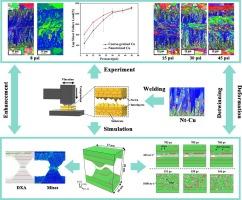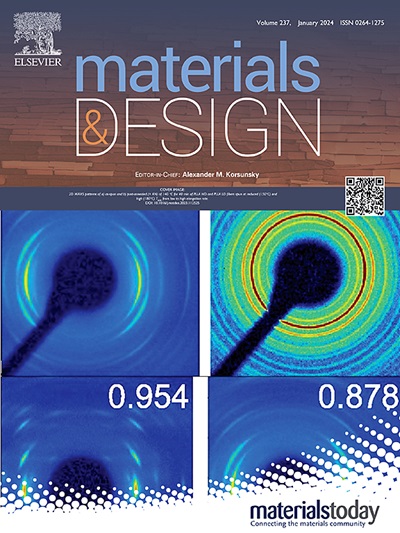在低能量输入超声波焊接坚固的铜-铜接头过程中,定制纳米细化铜夹层以实现各向异性塑性变形的局部化
IF 7.6
2区 材料科学
Q1 MATERIALS SCIENCE, MULTIDISCIPLINARY
引用次数: 0
摘要
超声波焊接以其严重的塑性变形而闻名,它面临的挑战是如何平衡焊接界面的充分变形与对基体的最小损伤。本研究利用了纳米孪晶铜(nt-Cu)的各向异性变形机制和机械性能。具体来说,在铜-铜接头的超声波焊接中,采用了与超声波振动方向平行的纳米孪晶层作为夹层。研究了 nt-Cu 夹层在不同焊接压力下对焊接质量和变形机制的影响。实验和分子动力学模拟证明,在低焊接压力下,nt-Cu 中间膜主要通过孪晶边界迁移发生变形和脱落。这种机制有效地减轻了焊接过程中的加工硬化,使变形集中在焊接界面,并显著提高了铜-铜接头的强度。最大的增强比例出现在焊接压力为 8 psi 时,与传统的粗粒铜相比,增强比例高达 26.75%。随着焊接压力的增加,强化效果逐渐减弱。nt-Cu 的变形机制过渡到位错横向和螺纹化。位错和孪晶边界之间的相互作用形成了不连贯的孪晶边界和 9R 相,导致界面区域加工硬化,强化效果减弱。本文章由计算机程序翻译,如有差异,请以英文原文为准。

Tailoring nanotwinned Cu interlayers for localizing anisotropic plastic deformation during low energy input ultrasonic welding of robust Cu-Cu joints
Ultrasonic welding, known for its severe plastic deformation, faces the challenge of balancing sufficient deformation at the welding interface with minimizing damage to the substrate. This study utilizes the anisotropic deformation mechanisms and mechanical properties of nanotwinned Cu (nt-Cu). Specifically, Cu coatings featuring nanotwin layers aligned parallel to the ultrasonic vibration direction were employed as interlayers in ultrasonic welding of Cu-Cu joints. The effects of the nt-Cu interlayer on the welding quality and the deformation mechanisms under the various welding pressures are investigated. Experimental and molecular dynamics simulations demonstrate that at low welding pressures, the nt-Cu interlayer undergoes deformation and detwinning primarily through twin boundary migration. This mechanism effectively mitigates work hardening during the welding process, localizes deformation at the welding interface, and significantly enhances the strengths of the Cu-Cu joints. The maximum enhancement proportion occurs at a welding pressure of 8 psi, up to 26.75% compared to conventional coarse-grained copper. As the welding pressure increases, the strengthening effect gradually weakens. The deformation mechanism of nt-Cu transitions to dislocation transverse and threading. The interaction between dislocations and twin boundaries forms incoherent twin boundaries and 9R phases, resulting in work hardening of the interfacial regions and reduction of the strengthening effect.
求助全文
通过发布文献求助,成功后即可免费获取论文全文。
去求助
来源期刊

Materials & Design
Engineering-Mechanical Engineering
CiteScore
14.30
自引率
7.10%
发文量
1028
审稿时长
85 days
期刊介绍:
Materials and Design is a multi-disciplinary journal that publishes original research reports, review articles, and express communications. The journal focuses on studying the structure and properties of inorganic and organic materials, advancements in synthesis, processing, characterization, and testing, the design of materials and engineering systems, and their applications in technology. It aims to bring together various aspects of materials science, engineering, physics, and chemistry.
The journal explores themes ranging from materials to design and aims to reveal the connections between natural and artificial materials, as well as experiment and modeling. Manuscripts submitted to Materials and Design should contain elements of discovery and surprise, as they often contribute new insights into the architecture and function of matter.
 求助内容:
求助内容: 应助结果提醒方式:
应助结果提醒方式:


